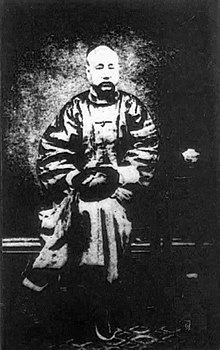Sengge Rinchen

Sengge Rinchen also Senggelinqin (僧格林沁, 1811-1865)a Mongol nobleman and general during the Qing dynasty, who is mainly known for his role during the Second Opium War and the suppression of the Taiping and Nian rebellions.
Background
Sengge Rinchen came from the Horqin Left Black Banner in Inner Mongolia and belonged to the Borjigin clan, which could trace its origins back to Genghis Khan. His personal name consists of the Tibetan words for "lion" and "treasure" respectively. In 1825, he became an imperial prince of the second degree (郡王).
Military role
Sengge Rinchen is mainly known for his role in a number of military campaigns in the mid-nineteenth century. In 1853, Sengge Rinchen stopped the northern expedition of Taiping army and captured one of its leaders, Li Kaifang. In 1855, Sengge Rinchen's status was elevated to Prince of the First Degree in recognition of this.
Four years later during the Second Opium War, he was appointed imperial commissioner in charge of leading the campaign against the British and French invasion. In 1859, he was defeated by the British and French forces at the Taku Forts and he was subsequently transferred to fight against the Nian rebellions, which he fought successfully and earned him back all his former titles and ranks. In 1865, during a campaign against the Nian Shandong, Sengge Richen was ambushed by a group of Nian rebels and killed. The Nian rebellion was finally suppressed in 1868.
Legacy
Following his death, the imperial court canonized Sengge Rinchen in recognition of his service to the Qing dynasty and made his rank as imperial prince hereditary under the name of the "loyal prince" (忠亲王). In 1889, Empress Dowager Cixi ordered that a shrine be erected in his memory under the name Xianzhongci (显忠祠), which still stands in the Dongcheng District in Beijing.
In official history works in the People's Republic of China's, Sengge Rinchen's Qing loyalist stance is interpreted as an expression of his Chinese patriotism, and in 1995, the local government of Tongliao in Inner Mongolia opened a Sengge Rinchen memorial museum. In Outer Mongolia, however, historians tend to give a less approving view of Sengge Rinchen, given his close association with China[citation needed].
References
- Hummel, Arthur William, ed. Eminent Chinese of the Ch'ing Period (1644-1912). 2 vols. Washington: United States Government Printing Office, 1943.
